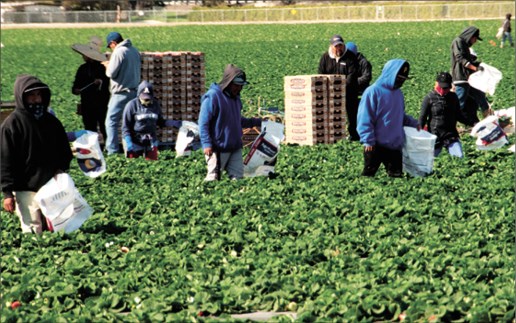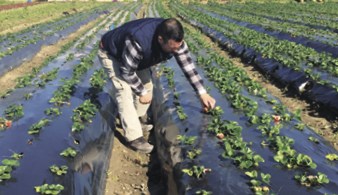February 17, 2019 - By Ching Lee - A series of storms in recent weeks has slowed California strawberry production, tightening supplies during a key marketing period and strengthening market prices.
A crew harvests strawberries in a field near Saticoy in Ventura County. The region produces the majority of California strawberries this time of year, but recent storms have curtailed harvest and reduced the amount of marketable fruit coming from the district.
Photo/John Krist
Ventura County produces the bulk of the state's strawberries this time of year, but a wetter winter so far has reduced the amount of marketable fruit coming from the Oxnard district.
"This time of year, the volume is all about the weather," said Carolyn O'Donnell, spokeswoman for the California Strawberry Commission.
Jeremy Ferro, a grower with Saticoy Berry Farms in Oxnard, said his production going into Valentine's Day—a major holiday for marketing strawberries—was off by 30 percent. Due to cosmetic damage from rain, he said what fruit he's managed to harvest has gone to processors for juice.
"We're not picking very much for the fresh market at all right now," he said. "It's going to be a tough deal for the stores, because the fruit is not going to be there."
John Krist, CEO of the Farm Bureau of Ventura County, described the weather impacts on berries as temporary, though there had been some "direct loss of ripe fruit, which doesn't like getting wet." Fields got muddy, he said, but they also "dried out pretty well, and damaged fruit is being harvested—or already has been—and sent for processing."
Ferro described these weather conditions as "normal" during winter harvest, and said breaks from the storms allowed his crews to clean up the plants and pick some fruit for the Valentine's Day push. He further noted how drier winters in recent years resulted in too much fruit on the market, which drove down prices for farmers.
The supply shortage has been made worse by fewer berries coming from Florida and Mexico in recent weeks.
Markon Cooperative, which supplies produce to food service, reported that cooler temperatures and rain limited Florida's production, though more-favorable weather in recent days had boosted the state's supply. Fruit from Mexico, Arizona and Texas was sufficient, the co-op said, but increased demand kept the market strong.
Considering his region's "dire need for water," Ventura County grower Will Terry said he's taking a long-term view on the rain and is "excited for a better irrigation water security moving forward."
"Certainly, there's short-term stress in terms of not having the fruit production we need to sell," he said. "But in recognition of the fact that we absolutely need the rain, I'm looking at the positive side of it and saying, 'Bring on the rain.'"
Though strawberries represent a small part of his diversified fruit and vegetable crop mix, Terry said it remains an important item for his direct-sales business, which relies primarily on farm stands and specific grocers.
Due to the size of the storms and the amount of rain and wind involved, he estimated he lost about three to four weeks of production. The specialty strawberry varieties he grows also produce less fruit, he said. A recent cold snap means his immature fruit will be slower to mature. And with more rain in the forecast this week, "that may totally wipe out our chances" of opening the farm stands on Valentine's Day, which he described as "one of our larger sales days."
"It's unfortunate that we may not able to provide (strawberries) at this time for our customers, but it's a long season, so we're hoping to recover from the rain and certainly benefit from it as well," Terry said. (Left) Farm manager Mike Roberts of Baby Root Farms in Camarillo inspects strawberries for damage and quality.
(Left) Farm manager Mike Roberts of Baby Root Farms in Camarillo inspects strawberries for damage and quality.
Photo/Phil McGrath
As an organic farmer in Ventura County, Phil McGrath said his strawberries grow much slower than conventional ones and he won't have much volume until mid-March. He's currently picking only about 20 to 30 boxes a week.
"We're doing OK," he said. "We don't have a lot of berries right now that are ready, so it's not hurting us that bad."
Despite the slower start, McGrath said the rain has caused some losses of what minimal fruit he has. His crews had to go through fields and dispose of any damaged or moldy fruit, so as not to spread the mold, he said. Otherwise, the plants "love the rain at this stage," he added.
The recent storms, which caused high-standing water in some fields, put an end to open-field strawberries that were planted in the summer, though strawberries in tunnels and hoop houses remain in production, said Oleg Daugovish, a University of California Cooperative Extension farm advisor in Ventura County. Farms also experienced losses in their fall-planted berries. Low temperatures, especially in more-inland parts of the county, caused pollination problems and resulted in unmarketable, misshapen fruit, he added.
"Aside from rain damage directly in many cultivars, we had Botrytis gray mold like I haven't seen in a long time," Daugovish said.
Though he has production in Salinas, Santa Maria, Oxnard, Florida and Mexico, David Lawrence, president and owner of Red Blossom, a grower-shipper-packer based in Los Olivos, said he won't have "any considerable volume" until March, when production in Santa Maria begins to pick up. Having some production in Oxnard allows him to "catch a little bit more of that early marketing window," when there's not much competing fruit on the market and prices are historically higher, he said. But with rain curtailing harvest, he said his crews have picked about a thousand boxes, which he described as "nothing" compared to the last three years, when weather was more favorable for production.
"This year, we got a considerable amount of rain to hold back production. It's the perfect scenario for a high market," he said.
Kevin Gee, a grower in Santa Maria, said a bumper crop last year "killed the market," adding that the financial hit was especially hard for smaller growers, leading some to get out of the business and others to reduce strawberry acreage.
The strawberry commission reported a 12 percent decline in California acreage during the last three years, though it noted that "total volume for each of those years has achieved record production." It said growers continue to shift to newer, higher-yielding varieties, and with normal weather, volume from mid-April through the end of October is "likely to equal or exceed" the three-year average.
(Ching Lee is an assistant editor of Ag Alert. She may be contacted at clee@cfbf.com.)
Reprinted with permission: California Farm Bureau Federation








